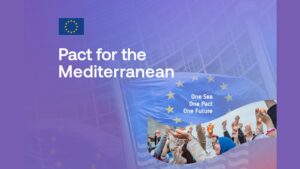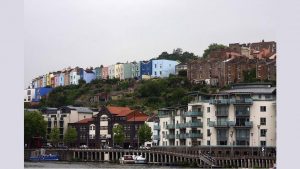In my previous “Museum of Europe” blog posts, I have mainly touched on topics related to competitiveness, such as the decline of economic competitiveness, the loss of share in the world economy, the lack of patents, the lack of IT sovereignty of the continent, etc. These issues clearly show that the strength, role and importance of the old continent are unfortunately shrinking very spectacularly in the 21st century and most of its leaders do not seem to be working to reverse this trend, which is unfavourable to us, but are continuing to reinforce our insignificance by pursuing an ostrich policy, often denying the facts. And we are even pleased when an analysis reveals our growing disadvantage and makes proposals in the fields of innovation, energy prices, competitiveness, the unity of the common market, economic and social cohesion – see the recent reports by Mario Draghi and Enrico Letta. Unfortunately, however, substantive and concrete actions from real decision-makers are still a long way off.
Our continent, which has played a leading role for the past two thousand years and is justifiably proud of its cultural richness, is becoming a ‘museum’ not only in the areas of competitiveness mentioned above, but also, and more importantly, in the rapid replacement of its population, facilitated by the majority of European decision-makers in power. Lord David Frost, former Chief Brexit Negotiator and former Minister for EU Relations and Member of the House of Lords in his speech at the Ludovika Festival on 8 May 2025, also drew our attention to the fact that 40% of London’s current population was not born in the UK. While London is indeed the top city in Europe with an increasing number of foreign-born residents, it is not a unique phenomenon at all.
- London, UK – 40.6%
- Malmö, Sweden – 34.4%
- The Hague, Netherlands – 32.8%
- Amsterdam, Netherlands – 32.1%
- Manchester, UK – 31.4%
- Vienna, Austria – 31.3%
- Rotterdam, Netherlands – 28.6%
- Gothenburg, Sweden – 27.5%
- Copenhagen, Denmark – 26.3%
- Birmingham, United Kingdom – 25.6%
Sources: ONS 2021, SCB 2019, CBS 2019, Stadt Wien 2023, DST 2022 cited by Global Statistics
Of course, it can be argued that similar trends are taking place not only in Europe but also in other parts of the world, just look at a similar statistic at global level:
| City | Country | Year and source of data (if available) | Foreign-born population | % | |
| 1 | Dubai | United Arab Emirates | Government of Dubai 2021 | 3,200,000 | 91.4% |
| 2 | Doha | Qatar | 2021 | 1,768,000 | 88.4% |
| 3 | Abu Dhabi | United Arab Emirates | 2014 | 2,173,000 | 80.0% |
| 4 | Image from | Images from | 2018 | 2,088,000 | 69.6% |
| 5 | Brampton | Canada | Canada 2021 Census | 383,695 | 59.1% |
| 6 | Miami | United States | 2022 ACS | 256,805 | 57.9% |
| 7 | Mississauga | Canada | Canada 2021 Census | 406,455 | 57.0% |
| 8 | Toronto | Canada | Canada 2021 Census | 1,431,380 | 51.9% |
| 9 | Surrey | Canada | Canada 2021 Census | 285,620 | 50.8% |
| 10 | Vancouver | Canada | Canada 2021 Census | 317,190 | 48.8% |
| 11 | Sydney | Australia | 2021 Australian Census | 2,260,410 | 43.2% |
| 12 | Auckland | New Zealand | Statistics New Zealand 2018 | 714,480 | 41.6% |
| 13 | San Jose | United States | 2022 ACS | 410,543 | 41.0% |
| 14 | Montreal | Canada | Canada 2021 Census | 790,960 | 40.9% |
| 15 | London | United Kingdom | ONS 2021 | 3,576,000 | 40.6% |
Source: Wikipedia
However, the reality behind the statistics is different in each region: Dubai, Doha, Abu Dhabi, Kuwait, like Europe, welcome foreigners for economic reasons, but they do so in a strictly regulated way, mostly through large temporary employment agencies and intermediaries, usually for a limited period of time, and only in the rarest cases can they acquire citizenship. In other words, the majority of foreign-born residents in the Middle East are workers and not immigrants.
Canada, like the EU, has made immigration extremely easy, as illustrated by the fact that five of the top ten cities in the World with the highest proportion of foreign-born residents are in Canada. Remarkably, more than half of the residents of these Canadian cities were not born in Canada.
The foreign-born are those who were not born in their country of residence. Although the UN, the US, the EU and other regions and countries have different legal definitions of the ‘foreign-born’, in principle, immigrants with the intention of settling and workers working abroad are the two most important groups of foreign-born everywhere. However, nowhere does this concept, and thus the statistics above, include second or third generation immigrants who were born there and who are citizens in the most cases.
The demographic transformation under way goes far beyond simple statistical trends: the cultural, identity and civilisational face of Europe is changing fundamentally. Mass immigration, often driven by political will, is not just a labour market issue but has profound social and cultural consequences. The increasingly diverse ethnic and religious composition brings with it new norms, values and patterns of behaviour, often radically different from the historical traditions of European societies. Second- and third-generation immigrants, although formally recorded as ‘indigenous’ in statistics, often retain and transmit their own identities, distinct from their original culture. This does not necessarily automatically imply conflict, but it undoubtedly poses challenges to cohesion, integration and social unity. Europe is thus becoming a ‘museum’ not only in economic terms, but also in cultural terms: the trappings of the past – buildings, monuments – are preserved, but the civilisational content behind them is slowly fading.
Source of opening image: ChatGPT, prompt: Create a 16:9 image with the theme: Museum of Europe: European indigenous peoples and conquerors.






